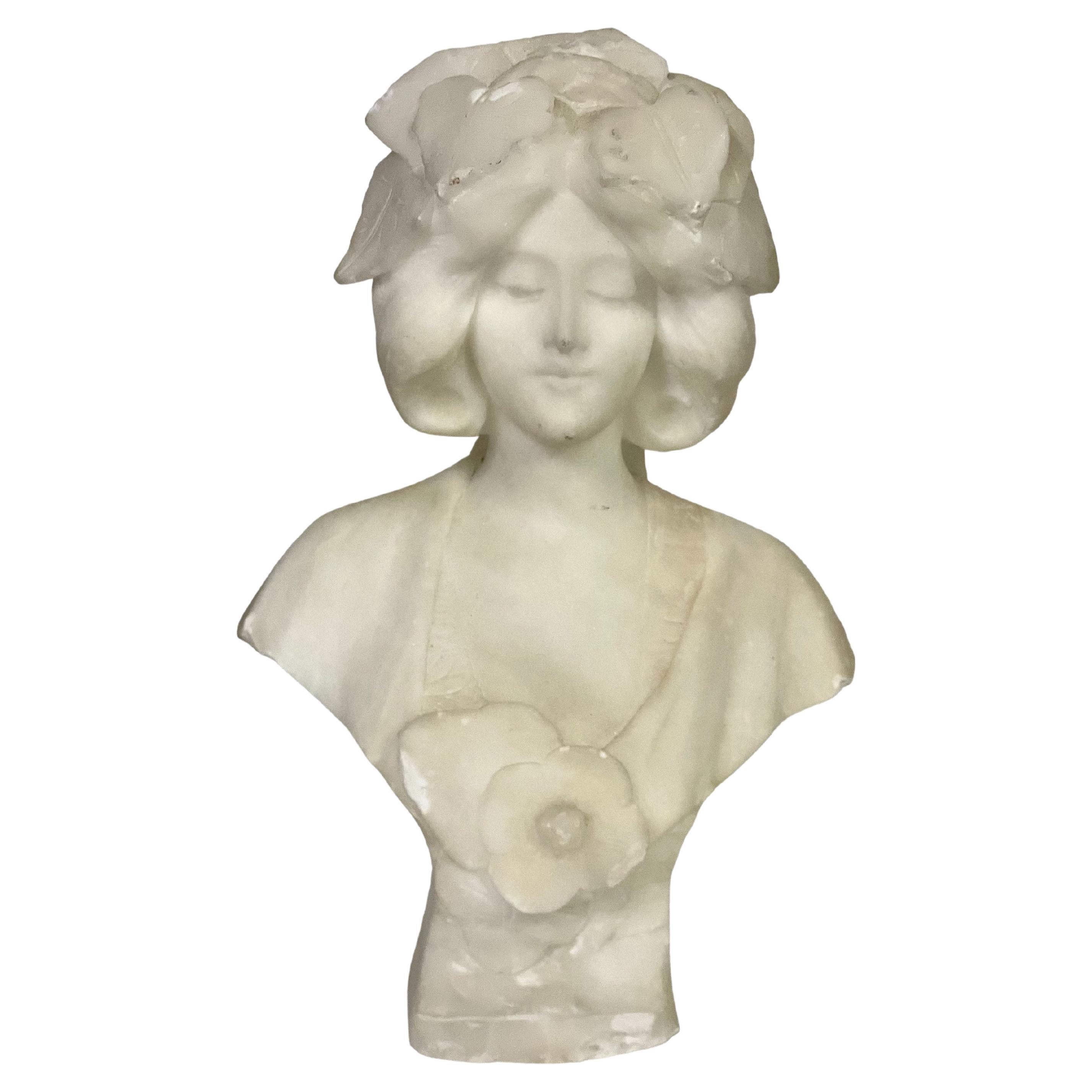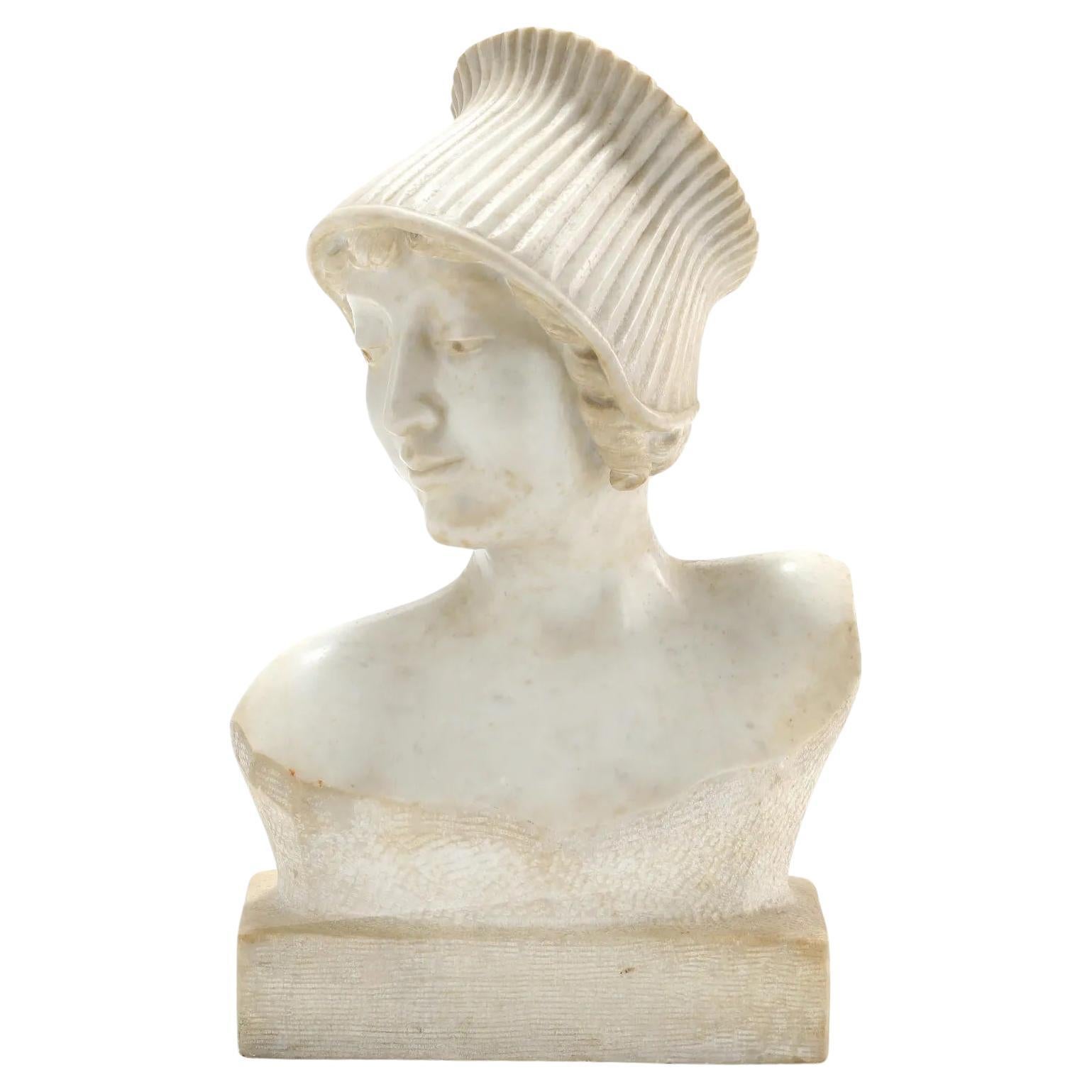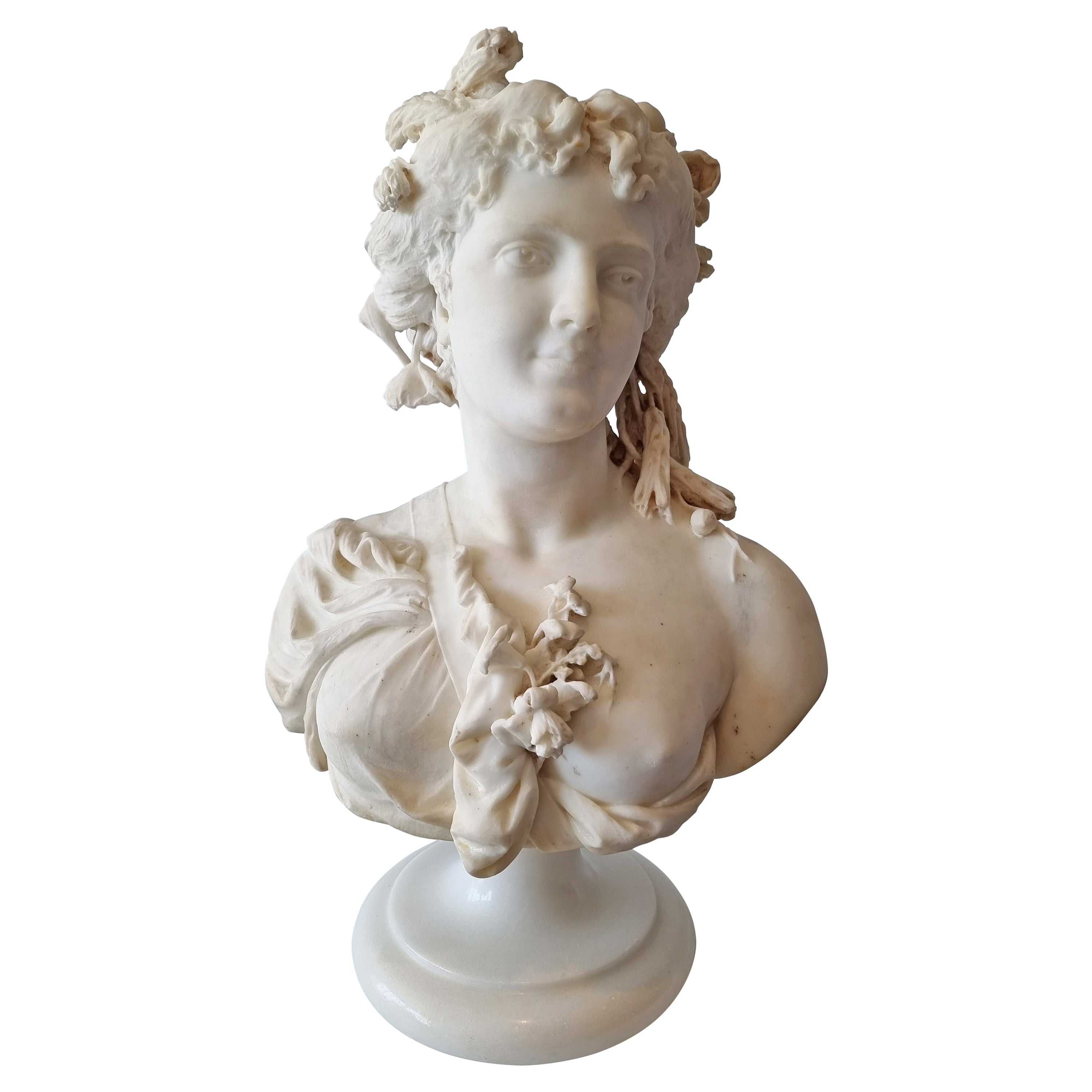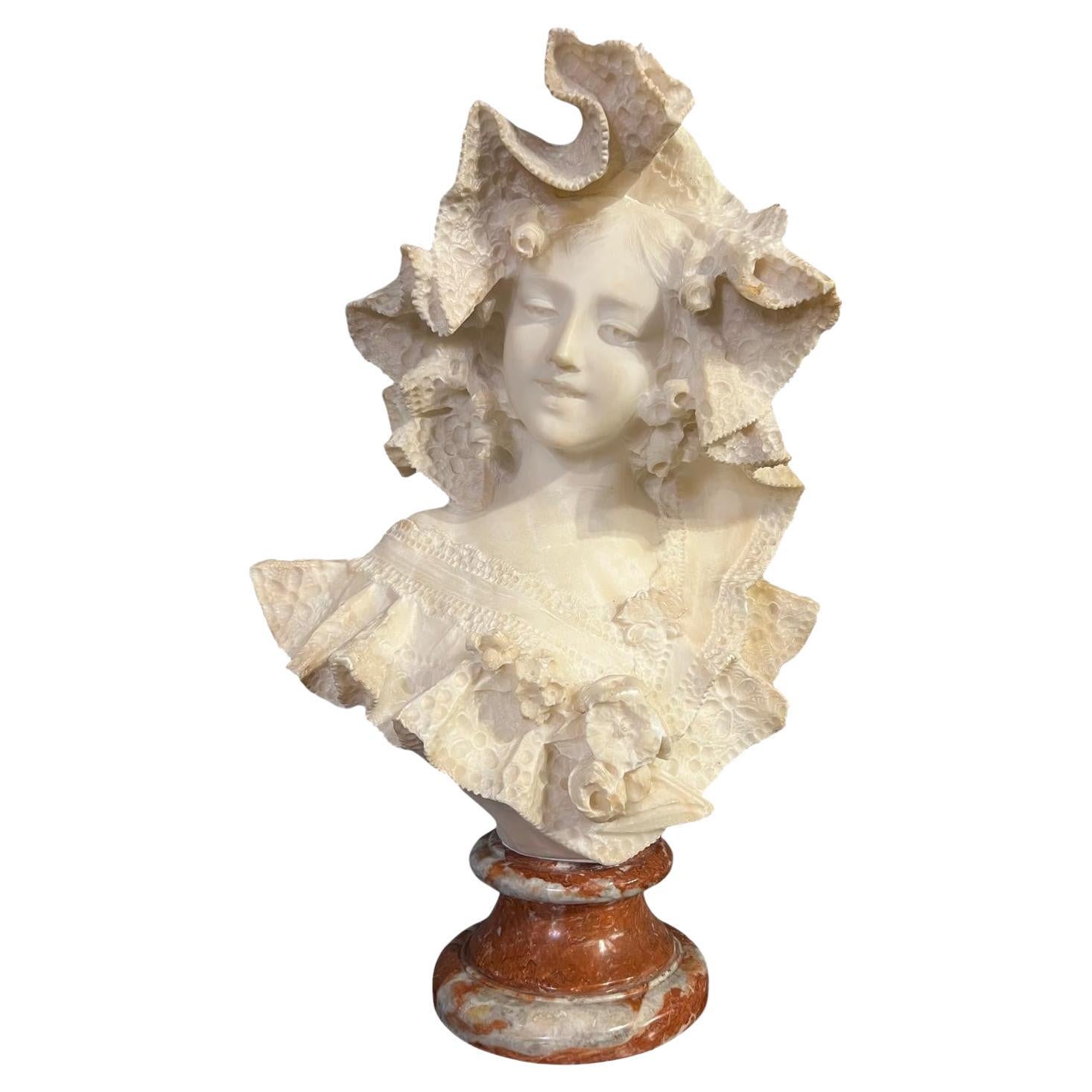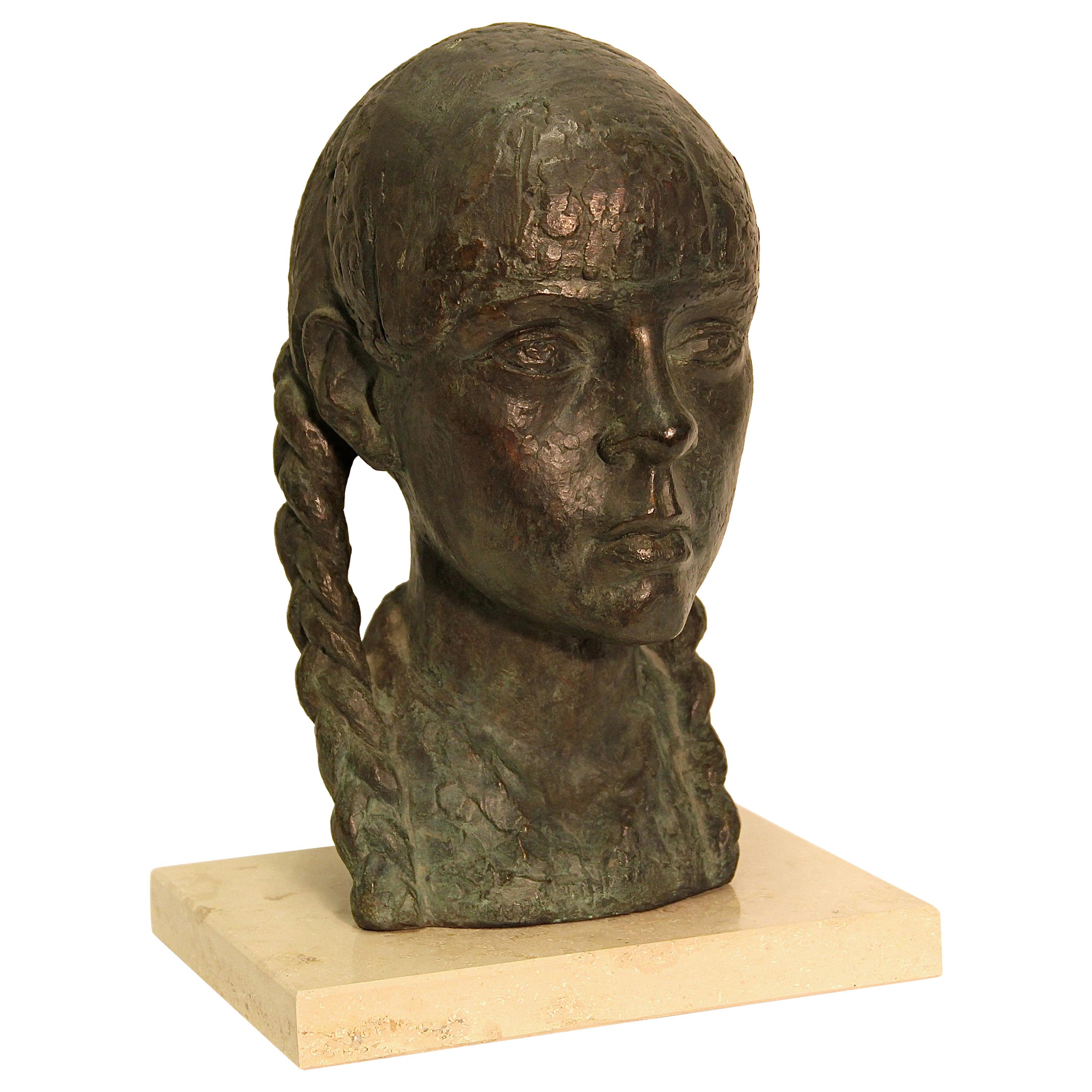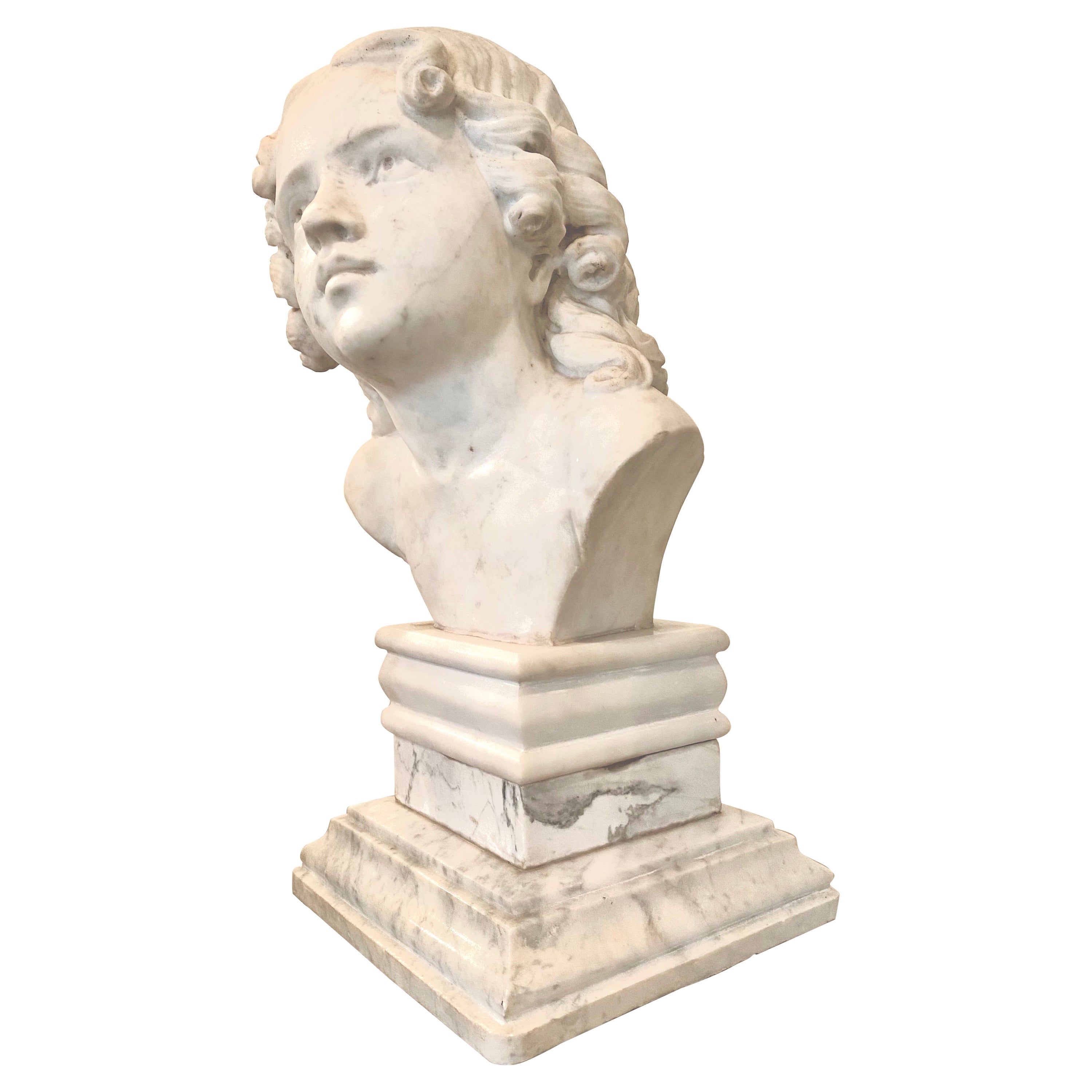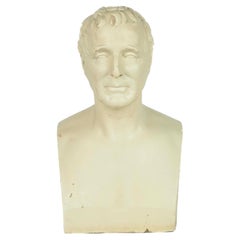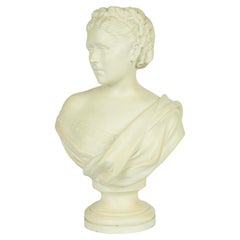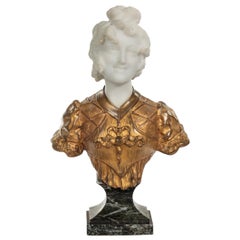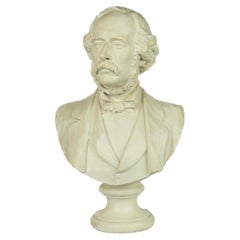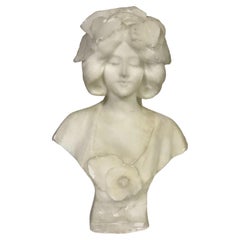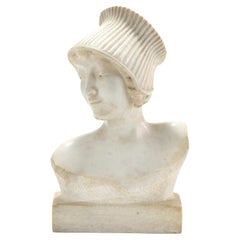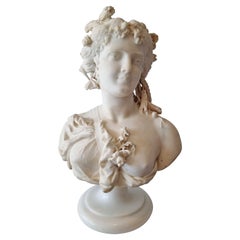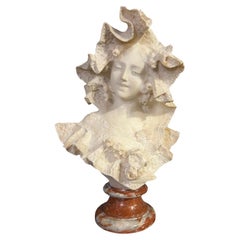Items Similar to Marble Bust of a Young Lady as Flora by John Adams-Acton
Want more images or videos?
Request additional images or videos from the seller
1 of 5
Marble Bust of a Young Lady as Flora by John Adams-Acton
About the Item
Marble Bust of a Young lady as Flora by John Adams-Acton (English, 1830-1910)
Signed and dated: JOHN ADAMS-ACTON FECT ROMA 1864 with inscription ELLEN A. HALL
White Marble
Provenance: Adams-Acton won the Royal Academy’s Gold Medal for sculpture in 1858 and his prize was to study in Rome under John Gibson, the important British Neoclassical sculptor. This bust of a young lady as Flora, Roman goddess of flowers and the Spring, was probably executed by Adams-Acton in Gibson’s studio in Rome, where he spent a successful period making portraits of Grand Tour patrons. The inscription, ‘Ellen A. Hall’, is probably the name of the sitter, who was most likely a young British tourist in Rome. Adams-Acton exhibited regularly at the Royal Academy from 1854 until 1892, where his sitters included William Gladstone, Charles Dickens and Pope Leo XIII.
An Exceptional marble portrait bust of the diarist and traveller Ellen Hall by the sculptor John Adams-Acton, executed in Rome in 1864
An Exceptional marble portrait bust of the diarist and traveller Ellen Hall by the sculptor John Adams-Acton, executed in Rome in 1864
Ellen, along with her sisters Louisa and Emily, moved to Ravenswood House in West Wickham, Kent, in 1842. They had previously spent many years in St Helier in Jersey. Ellen and Emily were extremely keen diarists and have left many records relating to their fascinating lives. They travelled widely and moved in some interesting circles, leading to them coming in to contact with the sculptor John Adams-Acton whilst in Rome. The sisters’ diaries are preserved in the Historical Collections department. of Bromley Library and Ellen writes of her visit to the sculptor that, on the 4th of February 1864 (page 259 in the diary):
“Went to Adams Studio and bought the little (illegible) bust. At Emily’s desire he will take a bust of me, which if it gives her any pleasure will not be money thrown away as I feel it to be myself. It will be £100 altogether, the little bust and myself. I like the man’s faces”.
This account also makes it very clear that the purchaser of the piece was to be Ellen’s sister Emily.
Later, on the 12th of February according to Ellen’s diary (page 269) she returned to the sculptor’s studio for her first sitting:
“The day was beautiful and I yet managed to go to Mr Adams and give him a long sitting…We chatted away as I was sitting but I began by being “furious” with him, telling him if anyone said to me “I understand you are sitting to Mr Adams” I should never come near the studio again”.
This latter comments relates to the fact that Ellen had been shown other portraits by Adams-Acton that were in the process of being finished and she was light-heartedly making it clear to the sculptor that she didn’t want her likeness to be shown to strangers. This also helps to make clear the Hall sister’s relationships with artistic figures in Rome during this period. They were clearly quite prominent patrons and connoisseurs.
In the spring of 1864, Emily and Ellen also both sat for the portrait painter G.B. Canevari.
Selections from the ladies’ diaries have since been published as memoirs, entitled the Halls of Ravenswood and Two Victorian Ladies
It is fascinating to have such detailed accounts of the lives of young women of the period.
John Adams-Acton
Adams-Acton won the Royal Academy’s Gold Medal for sculpture in 1858 and his prize was to study in Rome under John Gibson, the important British neoclassical sculptor. This bust of Ellen C. Hall was executed by Adams-Acton in his studio in Rome, where he spent a successful period making portraits of Grand Tour patrons. Adams-Acton exhibited regularly at the Royal Academy from 1854 until 1892, where his sitters included William Gladstone, Charles Dickens and Pope Leo XIII. He also executed sculptures of numerous aristocrats and members of the British Royal family with Edward VII in particular sitting for him on multiple occasions.
Literature: B. Read, Victorian Sculpture, Yale University Press, 1983
With particular thanks to Kate Bond at Bromley Historic Collections who helped to pinpoint relevant sections in the Ellen Hall diaries for us to examine.
- Dimensions:Height: 21.66 in (55 cm)Width: 15.75 in (40 cm)Depth: 11.82 in (30 cm)
- Materials and Techniques:
- Place of Origin:
- Period:
- Date of Manufacture:1864
- Condition:Wear consistent with age and use.
- Seller Location:Lymington, GB
- Reference Number:1stDibs: LU973018072051
About the Seller
5.0
Recognized Seller
These prestigious sellers are industry leaders and represent the highest echelon for item quality and design.
Established in 1982
1stDibs seller since 2013
128 sales on 1stDibs
Typical response time: 8 hours
Associations
LAPADA - The Association of Arts & Antiques Dealers
- ShippingRetrieving quote...Shipping from: Lymington, United Kingdom
- Return Policy
Authenticity Guarantee
In the unlikely event there’s an issue with an item’s authenticity, contact us within 1 year for a full refund. DetailsMoney-Back Guarantee
If your item is not as described, is damaged in transit, or does not arrive, contact us within 7 days for a full refund. Details24-Hour Cancellation
You have a 24-hour grace period in which to reconsider your purchase, with no questions asked.Vetted Professional Sellers
Our world-class sellers must adhere to strict standards for service and quality, maintaining the integrity of our listings.Price-Match Guarantee
If you find that a seller listed the same item for a lower price elsewhere, we’ll match it.Trusted Global Delivery
Our best-in-class carrier network provides specialized shipping options worldwide, including custom delivery.More From This Seller
View AllA painted plaster herm bust of the Duke of Wellington by George Gammon Adams
Located in Lymington, Hampshire
This plaster bust of Arthur Wellesley, 1st Duke of Wellington is a replica of the original marble portrait bust, commissioned, in 1852, by the Duke’s heir for Stratfield Saye, Hampsh...
Category
Antique 19th Century English Busts
Materials
Plaster
Victorian White Painted Terracotta Bust of a Young Woman
Located in Lymington, Hampshire
A Victorian white painted terracotta bust of a young woman, wearing a draped shawl over a bodice with a lace trim, her hair elaborately coiffed with a broad plait and multiple ringle...
Category
Antique 1860s English Victorian Busts
Materials
Terracotta
Marble and Ormolu Bust by Marionnet
Located in Lymington, Hampshire
A marble and Ormolu bust by Marionnet, showing the white marble head and shoulders of a girl with her hair in a bun and ringlets framing her face, wi...
Category
Antique 1890s French Busts
Materials
Marble, Ormolu
A plaster bust of a Victorian gentleman by Boehm
Located in Lymington, Hampshire
A plaster bust of a Victorian gentleman by Boehm, this white plaster bust shows an authoritative gentleman with a moustache and whiskers wearing a high collar and bow tie with a wais...
Category
Antique 1830s English Busts
Materials
Plaster
Fine Bronze Bust of ‘Dougie’ by Vivian Mallock
Located in Lymington, Hampshire
A fine bronze bust of ‘Dougie’ by Vivian Mallock depicting the head and smiling face of a Vincentian calypso singer with a dark patination becoming lighter at the end of his dreadloc...
Category
Early 2000s English Figurative Sculptures
Materials
Bronze
Charming Bust of a Child’s Head by Edwin Whitney-Smith, Dated, 1910
Located in Lymington, Hampshire
A charming bust of a child’s head by Edwin Whitney-Smith, dated 1910, the girl has her head slightly tilted forwards as she looks out from under a lock of hair, set on a square block signed on the reverse ‘E Whitney-Smith 1910’.
This bronze is a reduction of Whitney-Smith’s original marble piece, a photograph of which survives in the V&A (object number AAD/1990/12/63). Another version can be seen in a 1920s photograph of the artist in his studio owned by the National Portrait Gallery (NPG x194201). Neither the identity of the sitter nor title of the work is known.
Edwin Whitney-Smith (1880-1952) was one of the pre-eminent sculptors of his day. Born in Bristol in 1880, he became a student of William Harbutt, the headmaster of Bath School of Art, best remembered today for inventing plasticine. Whitney-Smith showed great promise from an early age, opening a studio in St John’s Wood, London, in 1910. He exhibited over 40 pieces at the Royal Academy and despite not achieving Academician status, even with list of illustrious proposers, he became a dear friend of Sir Alfred Munnings, the famous horse painter, and sculpted his portrait. He was, however, elected to the Royal Society of British Sculptors and his works were generally well-received by critics and the general public alike.
Aside from the RA, he exhibited in Bristol, at the Paris Salon and the Scottish Academy and his work attracted the attention of such important patrons as the Courtauld family. One of his most famous works, The Waking Child, is in the Ferens Art Gallery in Hull and another, The Irishman, is in the Tate. One version of his bust of Ernest Bevin, the trade unionist, stands in Tooley Street in Bermondsey to this day. An article in The Sphere, published on the 3rd of May 1924, referred to the sculptor as “a well-known sculptor of smiling children” and mentioned his “famous babies’ heads”.
Category
Vintage 1910s English Busts
Materials
Bronze
You May Also Like
Petite Alabuster Bust of a Young Lady
Located in LA CIOTAT, FR
This adorable petite alabaster bust of a young lady, her hair loosely styled and adorned with cascading leaves, exudes an air of grace and serenity. Her eyes are half shut and her fa...
Category
Early 20th Century French Busts
Materials
Alabaster
Art Deco Period White Carrara Marble Bust of a Young Lady
Located in Montreal, QC
Art Deco Period White Statuary Marble Bust of a Young Lady incised "ANIEV" to shoulder. From the Collection of Professor Roberto Severino, Washington, D.C. France: circa 1930
Category
Vintage 1940s French Busts
Materials
Carrara Marble
Italian Carrera Marble Bust of Flora
Located in London, GB
A very fine Italian Carrera marble sculpture of Flora. A beautiful young girl looking to dexter, she has her hair braided. Flora was the Roman...
Category
Antique 1860s Italian Busts
Materials
Carrara Marble
19th Century Bust of a Young Lady in White Marble by Flli Romanelli
Located in NICE, FR
We present you with this exquisite large bust of a beautiful young lady with a large hat, carved in prestigious antique white statuary marble. A unique work of the highest quality an...
Category
Antique 19th Century Italian Art Nouveau Busts
Materials
Marble
$3,364 Sale Price
20% Off
Impressionist Bronze Bust Sculpture of a Young Lady, on a Marble Base, Unsigned
Located in Berlin, DE
Impressionist bronze bust sculpture of a young lady. On a marble base.
Unsigned. Artist unknown.
Category
20th Century Busts
Materials
Marble, Bronze
$3,244 Sale Price
20% Off
Free Shipping
Marble Bust of a Young Man, Carrara Marble
Located in Montreal, Quebec
Marble Bust of a Young Man, Carrara Marble.
Category
Antique 19th Century French Neoclassical Busts
Materials
Carrara Marble
Recently Viewed
View AllMore Ways To Browse
Bust Of A Young Man
Roman Bust Black Marble
Marble Throne
Antique Wax Bust
Apollo Head
Female White Bust
Marble Bust French Woman
Weathered Bust
Black Bust Statue
Classical Busts Plaster
Marble Philosopher
Antique Bust Grand Tour
Ceramic Female Bust
Emperor Augustus
Bust Of Christ
Bronze Dante
Busts Of Philosophers
Diana Bust Sculpture
